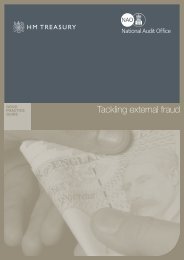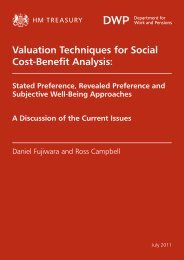4. First case study – the subdivision of the light - HM Treasury
4. First case study – the subdivision of the light - HM Treasury
4. First case study – the subdivision of the light - HM Treasury
You also want an ePaper? Increase the reach of your titles
YUMPU automatically turns print PDFs into web optimized ePapers that Google loves.
F05 Ch4 Subdivision <strong>of</strong> <strong>the</strong> <strong>light</strong>.doc<br />
05/04/2006 19:34:00<br />
Technological roulette <strong>–</strong> a multi-disciplinary <strong>study</strong> <strong>of</strong> <strong>the</strong> dynamics <strong>of</strong> innovation in electrical, electronic<br />
and communications engineering.<br />
<strong>4.</strong> <strong>First</strong> <strong>case</strong> <strong>study</strong> <strong>–</strong> <strong>the</strong> <strong>subdivision</strong> <strong>of</strong> <strong>the</strong> <strong>light</strong><br />
Edison took three steps to facilitate <strong>the</strong> changeover for potential customers. He first<br />
obtained an undertaking from <strong>the</strong> New York Board <strong>of</strong> Fire Underwriters that insurance<br />
rates would be unaffected if a Board inspector examined <strong>the</strong> wiring before connection was<br />
made to <strong>the</strong> street main. Secondly, <strong>the</strong> Illuminating company made it known every<br />
household in <strong>the</strong> district that <strong>the</strong> company would bear <strong>the</strong> cost <strong>of</strong> making <strong>the</strong> connection<br />
between <strong>the</strong> street main and <strong>the</strong> house wiring and <strong>the</strong> expense incurred in wiring <strong>the</strong><br />
building until <strong>the</strong> consumer had decided whe<strong>the</strong>r or not he wanted <strong>the</strong> electric <strong>light</strong><br />
permanently. Any consumer who, after a period <strong>of</strong> trial, decided not to continue with <strong>the</strong><br />
Edison <strong>light</strong> would not be charged for <strong>the</strong> wiring or <strong>the</strong> connection. Finally, in order to<br />
prove <strong>the</strong> reliability <strong>of</strong> <strong>the</strong> system, <strong>the</strong>re was to be a three-month moratorium after<br />
connection before charging commenced.<br />
The output <strong>of</strong> <strong>the</strong> Edison lamp was 16-candle power, matching that <strong>of</strong> <strong>the</strong> ordinary<br />
gas jet. The Illuminating Company billed on a monthly basis, like <strong>the</strong> gas companies and<br />
<strong>the</strong> lamps were usually referred to as burners. The customer was billed for <strong>light</strong>-hours<br />
consumed instead <strong>of</strong> for electric energy to avoid introducing terminology with which <strong>the</strong><br />
consumer would not be familiar.<br />
Some years later, when electric <strong>light</strong>ing was well established, it had a reciprocal<br />
influence on <strong>the</strong> gas-distribution system as gas engineers adopted <strong>the</strong> electric feeder-main<br />
principle in order to equalise gas pressure at <strong>the</strong> jets without incurring <strong>the</strong> expense <strong>of</strong><br />
larger pipes.<br />
<strong>4.</strong>5 Sources based on refractory oxides<br />
<strong>4.</strong>5.1 Lime<strong>light</strong><br />
In June 1824, at <strong>the</strong> instigation <strong>of</strong><br />
a Select Committee <strong>of</strong> <strong>the</strong> House <strong>of</strong><br />
Commons, a survey <strong>of</strong> Ireland was<br />
undertaken by <strong>the</strong> Royal Engineers. A<br />
high-intensity source <strong>of</strong> illumination<br />
was required to pinpoint observation<br />
Rees 1978<br />
Fig. <strong>4.</strong>11 Oxy-hydrogen lime<strong>light</strong> lamp (1830)<br />
posts and, after a series <strong>of</strong> experiments, Lieutenant Thomas Drummond built a device in<br />
which a ball <strong>of</strong> quicklime 3 /8 inch in diameter was heated in a stream <strong>of</strong> oxygen directed<br />
73





![AIRTO [Professor Dr Brian Blunden] - HM Treasury](https://img.yumpu.com/15492848/1/184x260/airto-professor-dr-brian-blunden-hm-treasury.jpg?quality=85)










